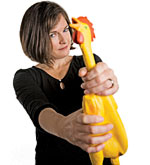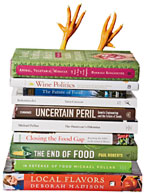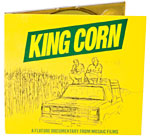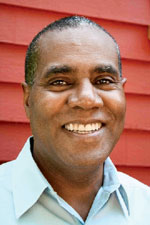sierraclub.org - sierra magazine - march/april 2009 - mixed media


Mixed Media
Try a side of politics with your next meal
 Food blogger Bonnie Azab Powell has plenty to cluck about.
Food blogger Bonnie Azab Powell has plenty to cluck about.
"Eating is an agricultural act," wrote farmer and agrarian essayist Wendell Berry in 1990, reminding us that food is more than a product and urging eaters to assume responsibility beyond passive consumption. In the years since he wrote that, food-safety scares coupled with rising obesity rates have awakened a hunger among Americans to understand our broken food system, in which empty calories are cheap but healthcare costs have spiraled out of control. And a national discussion of food politics has sprouted practically overnight.
Eating is not only an agricultural act, these new voices tell us. It is also an ecological act, and a moral, political, and ethical one. If that sounds preachy, not to worry: The following books, films, and Web sites (foodies love to talk about food as much as eat it) do not scold but celebrate the pleasures of growing, cooking, and eating.
Michael Pollan's best-selling book The Omnivore's Dilemma (Penguin Press, 2006) represented a tipping point in public consciousness. Pollan's exploration of the farm-to-fork journey of four meals remains the best synthesis of the issues surrounding food, and the food movement has crowned him its unofficial spokesperson.
Animal, Vegetable, Miracle (HarperCollins, 2007)--by novelist Barbara Kingsolver, her daughter Camille Kingsolver, and her husband, Steven L. Hopp--covers similar territory as Omnivore's Dilemma but takes a different tack and tone: Kingsolver mixes personal accounts of her family's attempt to eat what they grow for a year with simple recipes, sidebars, and diary entries. If Pollan is the wry, professorial paterfamilias of food-politics writing, then Kingsolver is its cheerleading, occasionally nagging mom.
Having digested these two primers, the interested reader comes to a, ahem, fork in the road.
 Uphill lies food-politics graduate school. The past year has seen several wonkish, interdisciplinary tomes on the impact of the world's food system. The best is The End of Food (Houghton Mifflin, 2008) by Paul Roberts, author of The End of Oil. This sweeping chronicle of the global food economy builds elegantly on Roberts's first work, covering the backstory of how we got into this mess and looking ahead to what will happen when industrial agriculture can no longer depend on its three critical ingredients: cheap energy, abundant water, and a stable climate.
Uphill lies food-politics graduate school. The past year has seen several wonkish, interdisciplinary tomes on the impact of the world's food system. The best is The End of Food (Houghton Mifflin, 2008) by Paul Roberts, author of The End of Oil. This sweeping chronicle of the global food economy builds elegantly on Roberts's first work, covering the backstory of how we got into this mess and looking ahead to what will happen when industrial agriculture can no longer depend on its three critical ingredients: cheap energy, abundant water, and a stable climate.
Presenting a less grueling path are books that scrutinize a single serving of sustainable (or not) food. Taras Grescoe's Bottomfeeder (Bloomsbury USA, 2008) offers vivid anecdotes about the sorry state of the wild and farmed seafood industries, along with recommendations for making more ethical piscine choices. Other books that concentrate on a single food issue--like Claire Hope Cummings's Uncertain Peril (Beacon Press, 2008), about transgenic seeds and the dangers of corporate control of the food supply, or Mark Winne's Closing the Food Gap (Beacon Press, 2008), about improving low-income families' access to nourishing food--provide a lot of sustenance without sending you into a stupor.
If reading gets in the way of eating, several documentary films offer one-stop supping. The Future of Food (Cinema Libre, 2004), written, directed, and coproduced by Deborah Koons Garcia, covers the threats posed by genetically engineered food and seeds. More recent is 2007's King Corn (Mosaic Films Incorporated). Directed by Aaron Woolf, this appetizing little doc scrutinizes how U.S. food policy has led to the rise in obesity.
Amid an explosion of general cooking and eating blogs, Web sites and blogs covering food politics are thriving. Thanks to its food editor, business-journalist-turned-farmer Tom Philpott, the environmental news site Grist offers knowledgeable reporting on topics ranging from meat industry consolidation to biodynamic wine tastings. Eat Well Guide maintains a huge online database of where to find sustainable food that is searchable by zip code.
The site also has a blog, Green Fork, that offers tips, news, recipes, and commentary. Eating Liberally), Organic, Inc. author Samuel Fromartz's Chews Wise, and The Ethicurean (which I founded and edit) are other sources for the latest on what free-range really means and how the Obama administration's agriculture policy is shaping up.
By now your head may be spinning, and your stomach grumbling. What to eat after all this?
Simple. "Eat food. Not too much. Mostly plants," says Pollan in Dilemma's 2008 successor, In Defense of Food (Penguin Press). The kind of food he means, versus processed "edible foodlike substances," can best be found at one of the United States' 4,600 farmers' markets. It helps to know how to cook it. For that, Local Flavors (Broadway, 2002) by chef Deborah Madison is indispensable: Her simple, unfussy recipes are grouped by what appears seasonally at the markets. One of the most appealing aspects of the food movement is that eating fresh, delicious food is in itself a rebellious act. --Bonnie Azab Powell
Corn Maze
Excerpt from the Ethicurean, a group blog devoted to helping readers "chew the right thing." Writers contribute news roundups, commentary, and reviews, like this one of the 2007 documentary King Corn
by Ethicurean editor Bonnie Powell.
 The basics: Two twentysomething guys, Ian Cheney and Curt Ellis, move to Greene, Iowa, where both their great-grandfathers once lived, to grow an acre's worth of corn. By doing so, they hope to get a glimpse into how maize is so dramatically overproduced in this country that mountains of it sit next to full gigantic granaries, and why it has become the go-to cheap ingredient for processed food, fast food, and animal fodder.
The basics: Two twentysomething guys, Ian Cheney and Curt Ellis, move to Greene, Iowa, where both their great-grandfathers once lived, to grow an acre's worth of corn. By doing so, they hope to get a glimpse into how maize is so dramatically overproduced in this country that mountains of it sit next to full gigantic granaries, and why it has become the go-to cheap ingredient for processed food, fast food, and animal fodder.
The growing of the corn is mainly a storytelling device through which they explore the labyrinthine support system for cheap food in this country. Employing some adorable yet low-budget techniques like stop-motion photography of Fisher-Price farmers and kernels of corn marching across a map, they provide a succinct history of modern U.S. agriculture.
Earth Beat | Ear to the Ground
 Steve Curwood has hosted the syndicated public radio program Living on Earth since its first broadcast 18 years ago, covering issues that have since been resolved (ozone, Dan Quayle) and others that dog us to this day. Sierra talked with Curwood about radio's role in the age of multimedia and to hear about some American voices that are largely new to the airwaves.
Steve Curwood has hosted the syndicated public radio program Living on Earth since its first broadcast 18 years ago, covering issues that have since been resolved (ozone, Dan Quayle) and others that dog us to this day. Sierra talked with Curwood about radio's role in the age of multimedia and to hear about some American voices that are largely new to the airwaves.
How did you get interested in environmental issues?
My mother was an avid birder, and I grew up being dragged to different places to go birding. Early on she bought an old farmhouse with 30 acres, where I live now. That's one place where everything started, just being outdoors constantly.
It seems you could rerun many of your oldest stories now.
We were rolling out the show in 1991 as the first Gulf War was erupting. For a moment we felt we were going to get steamrolled and no one would hear us. But with the well fires and the war's huge ecological component, we've never looked back.
Here's what's changed. In the early 1990s, a Roper survey of media habits said that only 14 percent of the American public would be interested in climate change. Back then 60 to 70 percent of Americans were saying the environment was important, but not climate change.
Is it hard to tell a story in four to six minutes?
These are produced interviews, so you start with 25 to 35 minutes of material. It's like making a film. If you spend a day gathering tape, you'll spend four days getting it all to work. And that's for something fairly simple. We sometimes do 8- and 16-minute pieces.
What can your program do that others can't or won't?
As we understand more about nanoscale reactions, it becomes clearer why just a few molecules of dioxin or bisphenol-A could change genetic expression, the ability of people to reproduce, or our immune systems. A lot of media are having a hard time touching that. The chemical industry is militant, powerful, and rich. We've been thrown off the air in a couple of places where we've run stories that have upset the industry.
I'm proud that my staff and I never drank from the Kool-Aid, the idea that somehow you could balance a science story. If one person says two plus two is four, and another says two plus two is five, the right answer isn't four and a half. That's the way virtually all American media wanted to cover climate change, especially as industry stirred up clouds of doubt.
What's a story that surprised you?
Lead and its relationship to crime has been a stunner. The Cincinnati Lead Study has followed a cohort of kids from before birth--they're now in their late 20s--who lived in a tough, largely black part of Cincinnati, where there was horrific exposure to lead. Of 250 kids, 9 of them have already died in violent criminal incidents, as victims or aggressors. You look at the crisis in education in this country, and you see the effect lead poisoning has had on delinquency and crime and the ability to learn.
What's the benefit of offering your program online at loe.org?
People who are interested in environmental change seek us out online. We are heard through the Internet in 72 countries.
What are you working on now?
I'm developing a podcasting project with African Americans aged 18 to 30. In the next 20 years, half the people under 30 in this country will be people of color. And by 2040 or 2050, half the country. The podcasts are being done in a stylistic and cultural way that's responsive to the about-to-no-longer-be minority.
How do you reach youths without coming across as pandering?
It needs to sound authentic. It's important that people feel included by hearing people who sound like them and have similar experience in life. I spent my formative years in the Midwest, not far from Middletown, Ohio, which is the sound CBS picked to be the "American sound." I don't sound particularly African American. And up until recently, radio has made it a point that any kind of regionalism--whether it reflects color or not--is not part of the mix. That's changing, but typically when you don't hear people who sound like you or your friends or family, you feel like an outsider.
What story is ripe for the podcasts?
Consumption. A big symbol of making it out of the tough side of life is to have a cavernous house and a garage stuffed with fancy cars.
What new topics might you cover during the Obama administration?
My sense is that we'll see a partnership between the Senate and the White House on climate change.
What's your environmental vice?
An SUV that hauls a horse trailer.
—interview by Reed McManus
Photos, from top: Lori Eanes (2), Jennifer Stevens, Lori Eanes; used with permission.